Catchworks: A Historical Water-Distribution System on Mountain Meadows in Central Slovakia
Abstract
1. Introduction
2. Materials and Methods
2.1. The Study Area
2.2. Material
2.3. Methodology
2.3.1. Identification of Catchworks in a Digital Model
2.3.2. Multitemporal Analyses of Catchworks in Orthomosaics Using Break Lines of a Digital Model
2.3.3. Validation of Catchworks Using the Normalized Green-Red Difference Index and Delineation
2.3.4. Evaluation of Real and Potential Catchworks in Land Use Categories
3. Results
3.1. Detection of Catchworks in a Digital Model
3.2. Multitemporal Analysis of Catchworks Using Orthomosaics and Terrain Data of Break Lines
3.3. Validation of Catchworks Using the Normalized Green-Red Difference Index (NGRDI) and Delineation of Potential Catchworks
3.4. Evaluation of Catchworks in Land Use Categories
4. Discussion and Conclusions
4.1. Application of Digital Terrain Models in Catchworks Detection
4.2. Identification of Catchworks in Orthomosaic Photos and Using Vegetation Indices
4.3. Delineation of Catchworks and Implementation in Sustainable Land Use Planning
Supplementary Materials
Author Contributions
Funding
Institutional Review Board Statement
Informed Consent Statement
Data Availability Statement
Conflicts of Interest
References
- Hreško, J.; Petrovič, F.; Mišovičová, R. Mountain Landscape Archetypes of the Western Carpathians (Slovakia). Biodivers. Conserv. 2015, 24, 3269–3283. [Google Scholar] [CrossRef]
- Spulerova, J.; Dobrovodska., M.; Stefunkova., D. Driving Forces. Threats and Trends Relating to Mosaics in Agricultural Landscape in Slovakia. J. Landsc. Ecol. 2010, 3, 59–72. [Google Scholar] [CrossRef]
- Renes, H.; Centeri, C.; Eiter, S.; Gaillard, B.; Kruse, A.; Kučera, Z.; Puschman, O.; Roth, M.; Slámová, M. Water Meadows as European Agricultural Heritage. In Adaptive Strategies for Water Heritage; Hein, C., Ed.; Springer International Publishing: Cham, Switzerland, 2020; pp. 107–131. [Google Scholar] [CrossRef]
- Miklós, L.; Špinerová, A.; Belčáková, I.; Offertálerová, M.; Miklósová, V. Ecosystem Services: The Landscape-Ecological Base and Examples. Sustainability 2020, 12, 10167. [Google Scholar] [CrossRef]
- Williamson, T. Fodder Crops and the ‘Agricultural Revolution’ in England, 1700–1850. Environ. Archaeol. 1998, 1, 11–18. [Google Scholar] [CrossRef]
- Martins, S.W.; Williamson, T. Floated Water-Meadows in Norfolk: A Misplaced Innovation. Agric. Hist. Rev. 1994, 42, 20–37. [Google Scholar] [CrossRef]
- Cook, H.; Sterne, K.; Williamson, T. The Origins of Water Meadows in England. Agric. Hist. Rev. 2003, 51, 155–162. [Google Scholar] [CrossRef]
- Sterne, K.; Cook, H. Water Meadow Management in Wessex: Dynamics of Change from 1800 to the Present Day. Landsc. Res. 2015, 40, 377–395. [Google Scholar] [CrossRef]
- Leibundgut, C.; Kohn, I. European Traditional Irrigation in Transition Part I: Irrigation in Times Past—A Historic Land Use Practice Across Europe. Irrig. Drain. 2014, 63, 273–293. [Google Scholar] [CrossRef]
- Leibundgut, C.; Kohn, I. European Traditional Irrigation in Transition Part II: Traditional Irrigation in Our Time—Decline. Rediscovery and Restoration Perspectives. Irrig. Drain. 2014, 63, 294–314. [Google Scholar] [CrossRef]
- Kerridge, E. The Sheepfold in Wiltshire and the Floating of the Water Meadows. Econ. Hist. Rev. 1954, 6, 282–289. [Google Scholar] [CrossRef]
- Vasari, Y. The Ecological Background of the Livelihood of Peasants in Kuusamo (NE Finland) during the Period 1670–1970. In The Silent COUNTDOWN; Brimblecombe, P., Pfister, C., Eds.; Springer: Berlin/Heidelberg, Germany, 1990; pp. 125–134. [Google Scholar] [CrossRef]
- Slámová, M.; Jančura, P.; Fabriciusová, V.; Beláček, B.; Zrníková, K.; Prídavková, Z. Traditional Agricultural Practices. Land Cover Diversity and Biodiversity in the Southern Podpolanie Region. In Biocultural Diversity in Europe; Environmental History 5; Springer International Publishing: Cham, Switzerland, 2016; pp. 247–268. [Google Scholar] [CrossRef]
- Pusey, M.P. On the Theory and Practice of Water Meadows. J. R. Agric. Soc. Engl. 1849, 10, 462–479. Available online: https://books.google.sk/books/about/Journal_of_the_Royal_Agricultural_Societ.html?id=JHQZAQAAMAAJ&redir_esc=y (accessed on 6 September 2020).
- Taylor, C.; Smith, N.; Brown, G. Rowland Vaughan and the Origins of Downward Floated Water-Meadows: A Contribution to the Debate. Landsc. Hist. 2012, 28, 35–51. [Google Scholar] [CrossRef]
- Pearson, A.W.; Soar., P.J. Meadowlands in Time: Re-Envisioning the Lost Meadows of the Rother Valley, West Sussex, UK. Landsc. Hist. 2018, 39, 25–55. [Google Scholar] [CrossRef]
- Cutting, R.; Cummings, I. Water Meadows: Their Form. Ecology and Plant Ecology. In Water Management in the English Landscape; Cook, H.F., Williamson, T., Eds.; Edinburgh University Press: Edinburgh, UK, 1999; pp. 157–178. [Google Scholar]
- Leibundgut, C. Historical Meadow Irrigation in Europe—A Basis for Agricultural Development. Available online: http://hydrologie.org/redbooks/a286/iahs_286_0077.pdf (accessed on 6 September 2020).
- Slámová, M.; Beláček, B.; Jančura., P.; Prídavková, Z. Relevance of the Historical Catchwork System for Sustainability of the Traditional Agricultural Landscape in the Southern Podpolanie Region. Agric. Agric. Sci. Procedia 2015, 4, 10–19. [Google Scholar] [CrossRef]
- Sofia, G.; Tarolli, P.; Cazorzi, F.; Dalla Fontana, G. Channel Network Identification from High-Resolution DTM: A Statistical Approach. Hydrol. Earth Syst. Sci. 2010, 7, 9327–9365. [Google Scholar] [CrossRef]
- Pirotti, F.; Tarolli, P. Suitability of LiDAR Point Density and Derived Landform Curvature Maps for Channel Network Extraction. Hydrol. Process. 2010, 24, 1187–1197. [Google Scholar] [CrossRef]
- Rapinel, S.; Hubert-Moy, L.; Clément, B.; Nabucet, J.; Cudennec, C. Ditch Network Extraction and Hydrogeomorphological Characterization Using LiDAR-Derived DTM in Wetlands. Hydrol. Res. 2015, 46, 276–290. [Google Scholar] [CrossRef]
- Chudý, F.; Slámová, M.; Tomaštík, J.; Prokešová, R.; Mokroš, M. Identification of Micro-Scale Landforms of Landslides Using Precise Digital Elevation Models. Geosciences 2019, 9, 117. [Google Scholar] [CrossRef]
- McCoy, M.D.; Asner, G.P.; Graves, M.W. Airborne Lidar Survey of Irrigated Agricultural Landscapes: An Application of the Slope Contrast Method. J. Archaeol. Sci. 2011, 38, 2141–2154. [Google Scholar] [CrossRef]
- Bedford, S.; Simeoni, P.; Lebot, V. The Anthropogenic Transformation of an Island Landscape: Evidence for Agricultural Development Revealed by LiDAR on the Island of Efate, Central Vanuatu, South-West Pacific. Archaeol. Ocean. 2017, 53, 1–14. [Google Scholar] [CrossRef]
- Luo, L.; Wang, X.; Guo, H.; Lasaponara, R.; Zong, X.; Masini, N.; Wang, G.; Shi, P.; Khatteli, H.; Chen, F.; et al. Airborne and Spaceborne Remote Sensing for Archaeological and Cultural Heritage Applications: A Review of the Century (1907–2017). Remote Sens. Environ. 2019, 232, 111280. [Google Scholar] [CrossRef]
- Chase, A.S.Z.; Chase, D.Z.; Chase, A.F. LiDAR for Archaeological Research and the Study of Historical Landscapes. In Sensing the Past, Geotechnologies and the Environment; Masini, N., Soldovieri, F., Eds.; Springer Nature: Cham, Switzerland, 2017; pp. 89–100. [Google Scholar] [CrossRef]
- Gasparini, M.; Moreno-Escribano, J.C.; Monterroso-Checa, A. Photogrammetric Acquisitions in Diverse Archaeological Contexts Using Drones: Background of the Ager Mellariensis Project (North of Córdoba-Spain). Drones 2020, 4, 47. [Google Scholar] [CrossRef]
- Chudý, F.; Slámová, M.; Tomaštík, J.; Tunák, D.; Kardoš, M.; Saloň, Š. The Application of Civic Technologies in a Field Survey of Landslides. Land Degrad. Dev. 2018, 29, 1858–1870. [Google Scholar] [CrossRef]
- García-Ruiz, J.M.; Lasanta, T.; Nadal-Romero, E.; Lana-Renault, N.; Álvarez-Farizo, B. Rewilding and Restoring Cultural Landscapes in Mediterranean Mountains: Opportunities and Challenges. Land Use Policy 2020, 99, 104850. [Google Scholar] [CrossRef]
- The Geodesy, Cartography and Cadastre Authority of the Slovak Republic. Geoportál ZBGIS® Map Client. 2020. Available online: https://zbgis.skgeodesy.sk/mkzbgis?bm=zbgis# (accessed on 10 September 2020).
- Landscape Atlas of the Slovak Republic. Available online: http://globus.sazp.sk/atlassr/ (accessed on 30 August 2020).
- Fric, M.; Orena, M.; Strelcova, K.; Jezik, M.; Sitkova, Z. The Changes of Stem Circumference and Microclimatic Parameters of Spruce Forests in BR Poľana during the Vegetation Season of 2009. In Microclima and Mesoclima of Landscape Structures and Anthropogenic Environment, Proceedings, Skalní mlýn, Czech Republic, 2–4 February 2011; Stredova, H., Roznovsky, J., Litschmann, T., Eds.; Cesky Hydrometeorologicky Ustav: Prague, Czech Republic, 2011. [Google Scholar]
- Fabriciusova, V. Natural Values in the Area of the CHKO-BR Polana. (In Slovak). Available online: http://huskforwildlife.eu/assets/docs/Zbornik_referatov.pdf (accessed on 30 September 2020).
- Fabriciusová, V.; Slámová, M.; Jančura, P. Protection of Landscape Values in an Innovative Management Approach of the Polana Biosphere Reserve. UNISCAPE En-Route 2015, 1, 27–32. [Google Scholar]
- Petrovic, F. The Changes of the Landscape with Dispersed Settlement. Ekologia (Bratislava) 2016, 25, 5–89. Available online: http://publikacie.uke.sav.sk/sites/default/files/EkSup10621petr_0.pdf (accessed on 6 November 2020).
- Ira, V.; Huba, M.; Podolak, P. Quality of Life of Population Living in a Protected Area and Its Sustainable Development (Examples of the Protected Landscape Area Polana). Geogr. Slovaca 2008, 25, 97–122. [Google Scholar]
- Slovak Environmental Agency. The Ministry of Environment’s Map Service (OGC WMS 1.3.0). 2019. Available online: http://maps.geop.sazp.sk (accessed on 30 September 2020).
- Technical University in Zvolen. Historická Ortofotomapa Slovenska Centrum Excelentnosti pre Podporu Rozhodovania v Lese a Krajine, TU Zvolen. 2020. (In Slovak). Available online: http://mapy.tuzvo.sk/hofm/ (accessed on 6 October 2020).
- Leica Geosystems. Leica CS10/CS15 & GS SensorsUser Manual. 2020. Available online: https://smithsurveyingequipment.co.uk/wp/wp-content/uploads/2017/09/LEICA-CS10-CS15-GS-SENSOR-USER-MANUAL.pdf (accessed on 11 November 2020).
- Menegoni, N.; Giordan, D.; Perotti, C.; Tannant, D.D. Detection and Geometric Characterization of Rock Mass Discontinuities Using a 3D High-Resolution Digital Outcrop Model Generated from RPAS Imagery—Ormea Rock Slope, Italy. Eng. Geol. 2019, 252, 145–163. [Google Scholar] [CrossRef]
- Huang, H.; Cui, C.; Cheng, L.; Liu, Q.; Wang, J. Grid Interpolation Algorithm Based on Nearest Neighbor Fast Search. Earth Sci. Inform. 2012, 5, 181–187. [Google Scholar] [CrossRef]
- Chaplot, V.; Darboux, F.; Bourennane, H.; Leguédois, S.; Silvera, N.; Phachomphon, K. Accuracy of Interpolation Techniques for the Derivation of Digital Elevation models In Relation to Landform Types and Data Density. Geomorphology 2006, 77, 126–141. [Google Scholar] [CrossRef]
- GDAL. GDAL Documentation. 2020. Available online: https://gdal.org/programs/gdal_grid.html (accessed on 22 November 2020).
- SAGA System for Automated Geoscientific Analyses. SAGA-GIS Tool Library Documentation (v4.0.1), Tool Simple Filter. Available online: http://www.saga-gis.org/saga_tool_doc/4.0.1/grid_filter_0.html (accessed on 22 November 2020).
- SAGA System for Automated Geoscientific Analyses. SAGA-GIS Module Library Documentation (v2.2.5), Module Slope, Aspect, Curvature. Available online: http://www.saga-gis.org/saga_tool_doc/2.2.5/ta_morphometry_0.html (accessed on 22 November 2020).
- Zevenbergen, L.W.; Thorne, C.R. Quantitative Analysis of Land Surface Topography. Earth Surf. Process. Landf. 1987, 12, 47–56. [Google Scholar] [CrossRef]
- Thorne, C.R.; Zevenbergen, L.W.; Burt, T.P.; Butcher, D.P. Terrain Analysis for Quantitative Description of Zero-Order Basins. In Proceedings of the Corvallis Symposium: Erosion and Sedimentation, Corvallis, OR, USA, 3–7 August 1987; International Association of Hydrological Sciences: Wallingford, UK, 1987; Volume 165, pp. 121–130. [Google Scholar]
- ArcGIS for Desktop. Curvature Function. 2020. Available online: https://desktop.arcgis.com/en/arcmap/10.3/manage-data/raster-and-images/curvature-function.htm (accessed on 22 November 2020).
- Sancho-Adamson, M.; Trillas, M.I.; Bort, J.; Fernández-Gallego, J.A.; Romanyà, J. Use of RGB Vegetation Indexes in Assessing Early Effects of Verticillium Wilt of Olive in Asymptomatic Plants in High and Low Fertility Scenarios. Remote Sens. 2019, 11, 607. [Google Scholar] [CrossRef]
- Hunt, E.R.; Cavigelli, M.; Daughtry, C.S.T.; Mcmurtrey, J.E., III; Walthall, C.L. Evaluation of Digital Photography from Model Aircraft for Remote Sensing of Crop Biomass and Nitrogen Status. Precis. Agric. 2005, 6, 359–378. [Google Scholar] [CrossRef]
- Lussem, U.; Bolten, A.; Gnyp, M.L.; Jasper, J.; Bareth, G. Evaluation of RGB-Based Vegetation Indices from UAV Imagery to Estimate Forage Yield in Grassland. ISPRS Int. Arch. Photogram. Remote Sens. Spat. Inf. Sci. 2018, 1215–1219. [Google Scholar] [CrossRef]
- Hatari Labs. Vegetation and Biomass Indices Estimation with QGIS 3—Tutorial. 2020. Available online: https://www.hatarilabs.com/ih-en/vegetation-and-biomass-indices-estimation-with-qgis-3-tutorial (accessed on 22 November 2020).
- Tucker, C.J. Red and Photographic Infrared Linear Combinations for Monitoring Vegetation. Remote Sens. Environ. 1979, 8, 127–150. [Google Scholar] [CrossRef]
- Kubinský, D.; Weis, K.; Fuska, J.; Lehotský, M.; Petrovič, F. Changes in Retention Characteristics of 9 Historical Artificial Water Reservoirs Near Banská Štiavnica, Slovakia. Open Geosci. 2015, 1, 1–8. [Google Scholar] [CrossRef]
- Cucchiaro, S.; Fallu, D.J.; Zhang, H.; Walsh, K.; Van Oost, K.; Brown, A.G.; Tarolli, P. Multiplatform-SfM and TLS Data Fusion for Monitoring Agricultural Terraces in Complex Topographic and Landcover Conditions. Remote Sens. 2020, 12, 1946. [Google Scholar] [CrossRef]
- Chudá, J.; Hunčaga, M.; Tuček, J.; Mokroš, M. The Handheld Mobile Laser Scanners as a Tool for Accurate Positioning under Forest Canopy. ISPRS Int. Arch. Photogramm. Remote. Sens. Spat. Inf. Sci. 2020, 211–218. [Google Scholar] [CrossRef]
- Căteanu, M.; Ciubotaru, A. Accuracy of Ground Surface Interpolation from Airborne Laser Scanning (ALS) Data in Dense Forest Cover. ISPRS Int. J. of Geo Inf. 2020, 9, 224. [Google Scholar] [CrossRef]
- Tarolli, P. High-Resolution Topography for Understanding Earth Surface Processes: Opportunities and Challenges. Geomorphology 2014, 216, 295–312. [Google Scholar] [CrossRef]
- Walker, S.J.; Wilkinson, S.N.; van Dijk, A.I.J.M.; Hairsine, P.B. A Multi-Resolution Method to Map and Identify Locations of Future Gully and Channel Incision. Geomorphology 2020, 358, 107115. [Google Scholar] [CrossRef]
- De Castro, A.I.; Torres-Sánchez, J.; Peña, J.M.; Jiménez-Brenes, F.M.; Csillik, O.; López-Granados, F. An Automatic Random Forest-OBIA Algorithm for Early Weed Mapping between and within Crop Rows Using UAV Imagery. Remote Sens. 2018, 10, 285. [Google Scholar] [CrossRef]
- Piragnolo, M.; Masiero, A.; Pirotti, F. Open Source R for Applying Machine Learning to RPAS Remote Sensing Images. Open Geospat. Data Softw. Stand. 2017, 2, 16. [Google Scholar] [CrossRef]
- Al-Najjar, H.A.; Kalantar, B.; Pradhan, B.; Saeidi, V.; Abdul Halin, A.; Ueda, N.; Mansor, S. Remote Sensing Land Cover Classification from Fused DSM and UAV Images Using Convolutional Neural Networks. Remote Sens. 2019, 11, 1461. [Google Scholar] [CrossRef]
- Roy, S.; Sahu, A.S. Palaeo-Path Investigation of the Lower Ajay River (India) Using Archaeological Evidence and Applied Remote Sensing. Geocarto Int. 2016, 31, 966–984. [Google Scholar] [CrossRef]
- Mondini, A.C.; Guzzetti, F.; Reichenbach, P.; Rossi, M.; Cardinali, M.; Ardizzone, F. Semi-Automatic Recognition and Mapping of Rainfall Induced Shallow Landslides Using Optical Satellite Images. Remote Sens. Environ. 2011, 115, 1743–1757. [Google Scholar] [CrossRef]
- Jannoura, R.; Brinkmann, K.; Uteau, D.; Bruns, C.; Joergensen, R.G. Monitoring of Crop Biomass Using True Colour Aerial Photographs Taken from a Remote Controlled Hexacopter. Biosyst. Eng. 2015, 129, 341–351. [Google Scholar] [CrossRef]
- Belčáková, I.; Pauditšová, E.; Gazzola, P. Methods and Techniques in Landscape Impact Assessment. In Landscape Impact Assessment in Planning Processes; Walter de Gruyter: Berlin, Germany, 2018; pp. 77–111. [Google Scholar] [CrossRef]
- Riihimäki, H.; Heiskanen, J.; Luoto, M. The Effect of Topography on Arctic-Alpine Aboveground Biomass and NDVI Patterns. Int. J. Appl. Earth Obs. Geoinf. 2017, 56, 44–53. [Google Scholar] [CrossRef]
- Sharma, L.P.; Nilanchal, P.; Ghose, M.K.; Debnath, P. Synergistic Application of Fuzzy Logic and Geo-Informatics for Landslide Vulnerability Zonation—A Case Study in Sikkim Himalayas, India. Appl. Geomat. 2013, 5, 271–284. [Google Scholar] [CrossRef]
- Evard, M. Water Meadows: Living Treasures in the English Landscape; Forrest Text: Machynlleth, UK, 2005. [Google Scholar]
- Lieskovský, J.; Bezák, P.; Špulerová, J.; Lieskovský, T.; Koleda, P.; Dobrovodská, M.; Bürgi, M.; Gimmi, U. The Abandonment of Traditional Agricultural Landscape in Slovakia—Analysis of Extent and Driving Forces. J. Rural Stud. 2015, 37, 75–78. [Google Scholar] [CrossRef]
- Belcakova, I.; Psenakova, Z. Specifics and Landscape Conditions of Dispersed Settlements in Slovakia—A Case of Natural, Historical and Cultural Heritage. In Best Practices in Heritage Conservation and Management: From the World to Pompeii, Proceedings of the 12th International Forum of Studies—The Paths of the Merchants, Aversa, Italy, 12–14 June 2014; Piscitelli, M., Ed.; Scuola Pitagora Editrice: Napoli, Italy, 2014; pp. 261–268. [Google Scholar]
- Keenleyside, C.; Oppermann, R. A Farmer-Centred Outlook to Managing and to Maintaining High Nature Value Grasslands in Europe. In Grasslands in Europe of High Nature Value; Veen, P., Jefferson, R., de Smidt, J., van der Straaten, J., Eds.; KNNV Publishing: Zeist, The Netherlands, 2009; pp. 293–303. [Google Scholar] [CrossRef]
- Maskell, L.C.; Botham, M.; Henrys, P.; Jarvis, S.; Maxwell, D.; Robinson, D.A.; Rowland, C.S.; Siriwardena, G.; Smart, S.; Skates, J.; Tebbs, E.J.; Tordoff, G.M.; Emmett, B.A. Exploring Relationships between Land Use Intensity, Habitat Heterogeneity and Biodiversity to Identify and Monitor Areas of High Nature Value Farming. Biol. Conserv. 2019, 231, 30–38. [Google Scholar] [CrossRef]
- Kozelová, I.; Špulerová, J.; Miklósová, V.; Gerhátová, K.; Izakovičová, Z.; Kalivoda, H.; Kalivodová, M.; Kanka, R. The Role of Artificial Ditches and Their Buffer Zones in Intensively Utilized Agricultural Landscape. Environ. Monit. Assess. 2020, 192, 656. [Google Scholar] [CrossRef] [PubMed]
- Cook, B.I.; Shukla, S.P.; Puma, M.J.; Nazarenko, L.S. Irrigation as an Historical Climate Forcing. Clim. Dyn. 2015, 44, 1715–1730. [Google Scholar] [CrossRef]
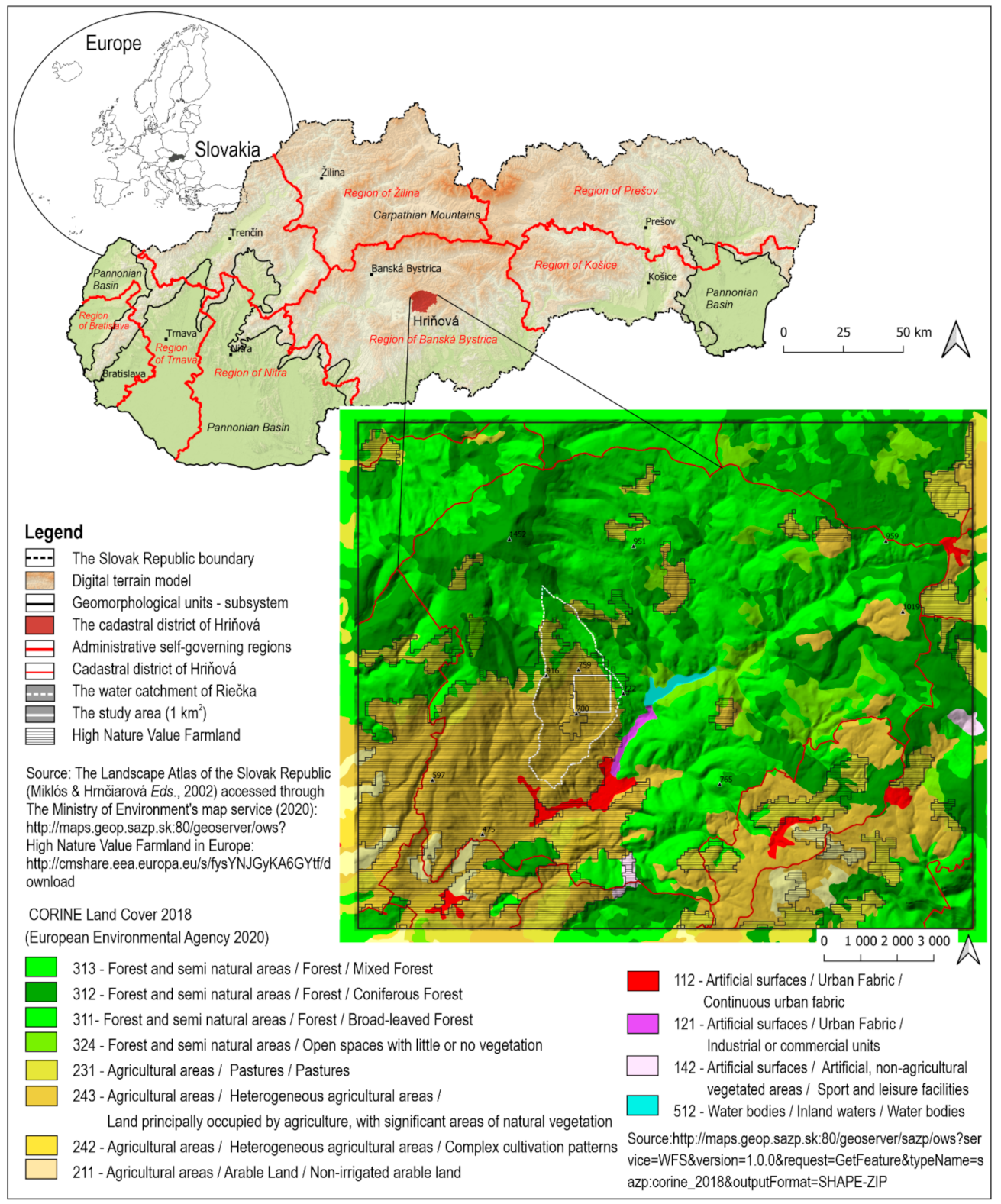
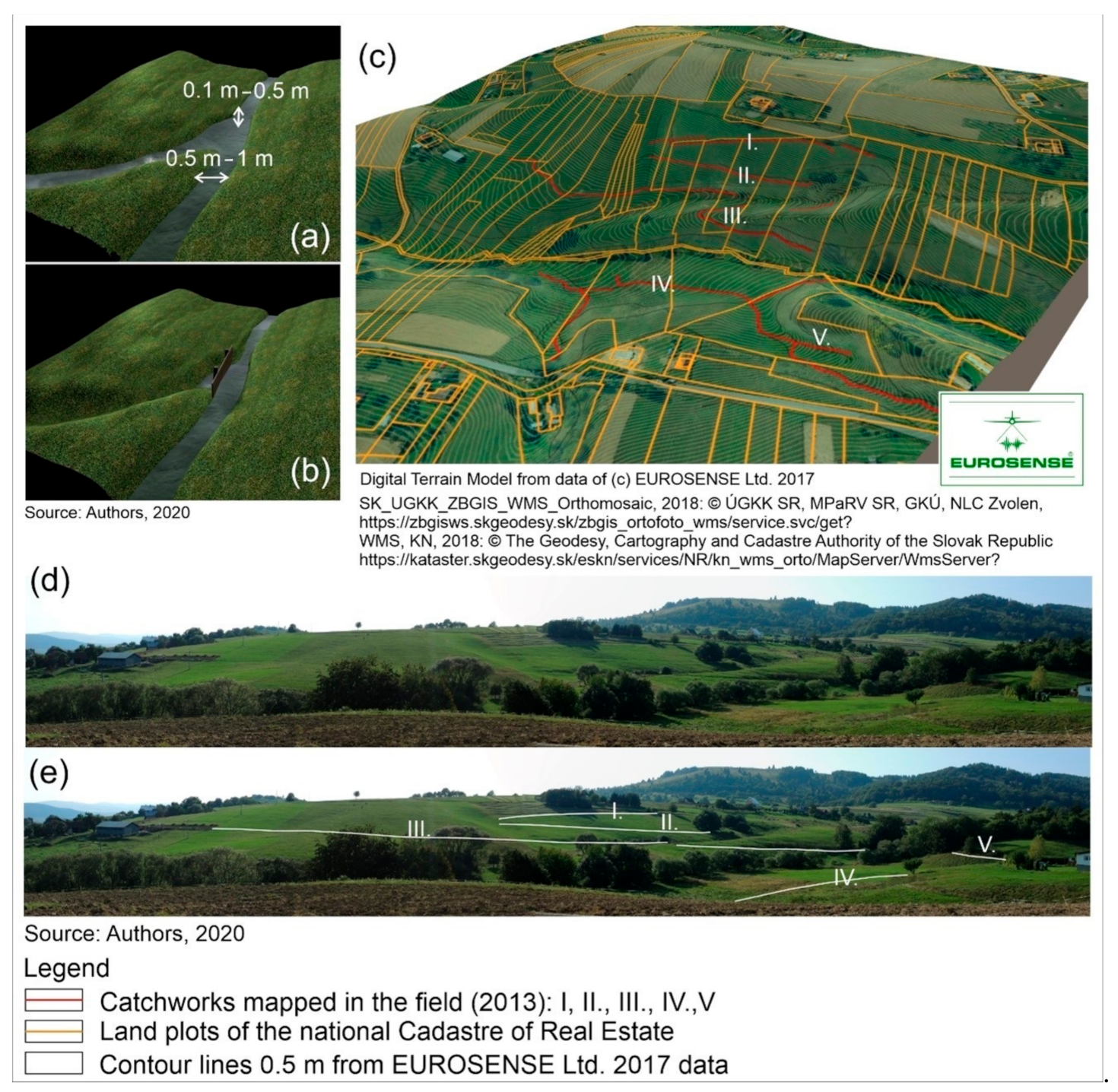
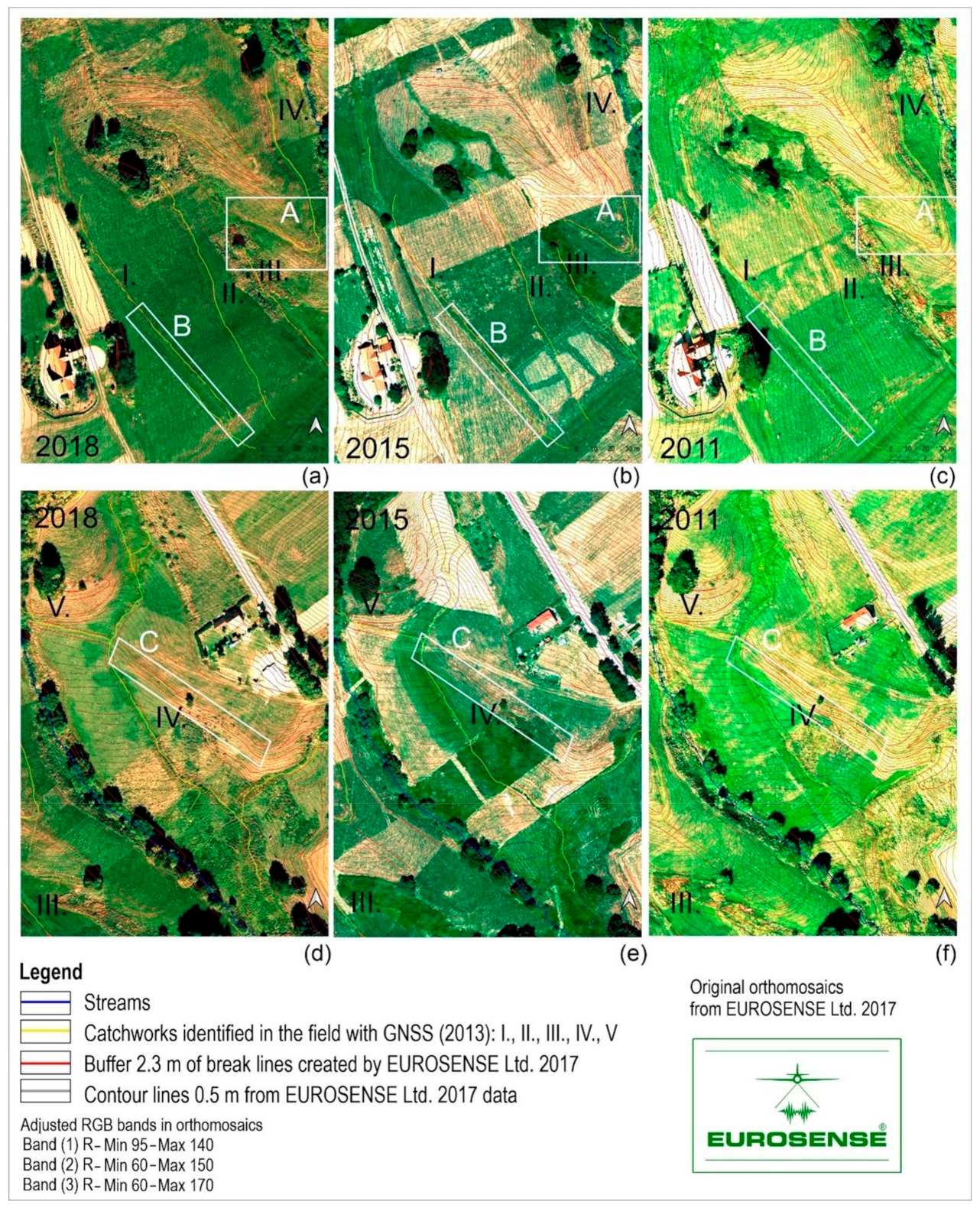
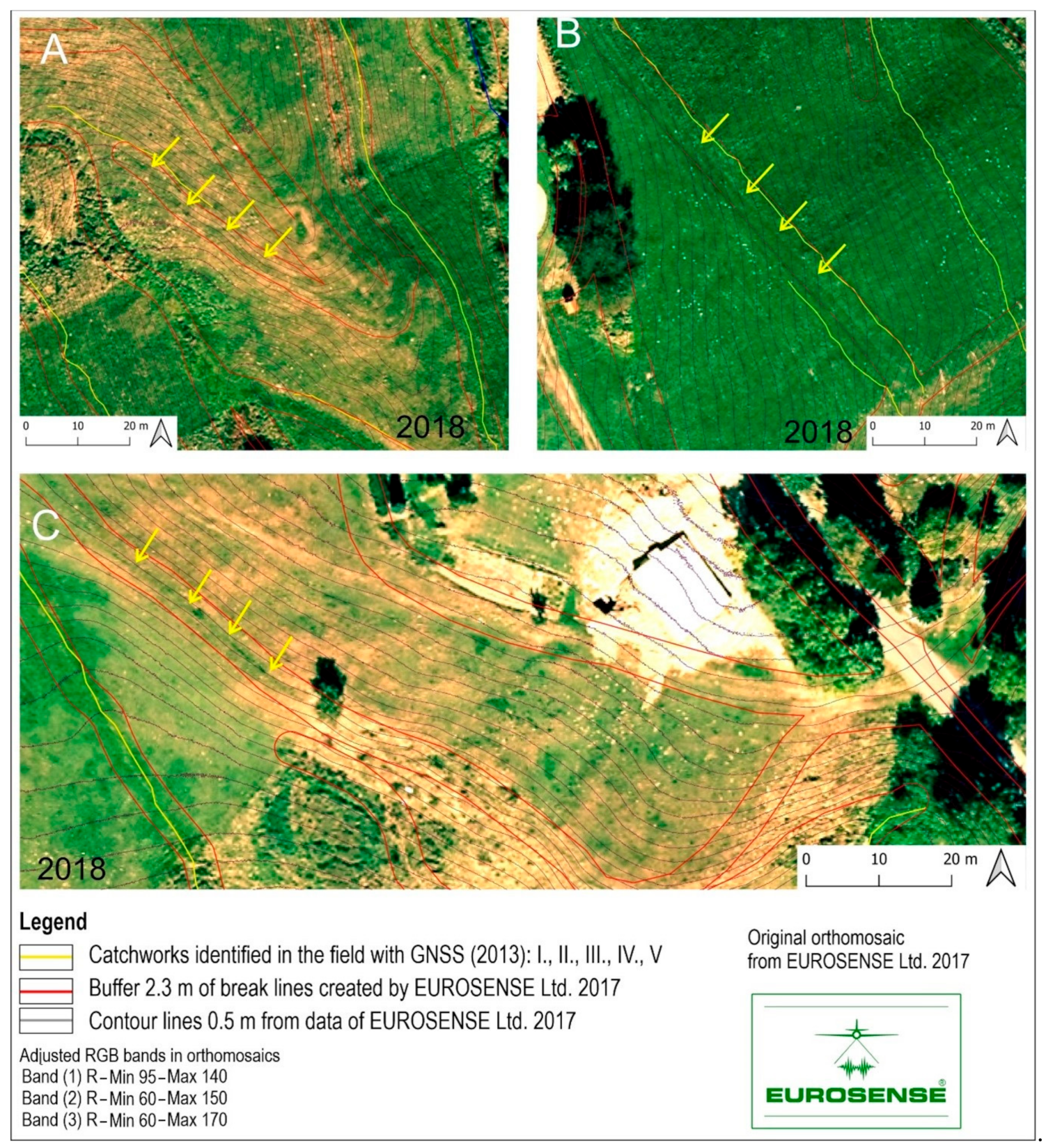
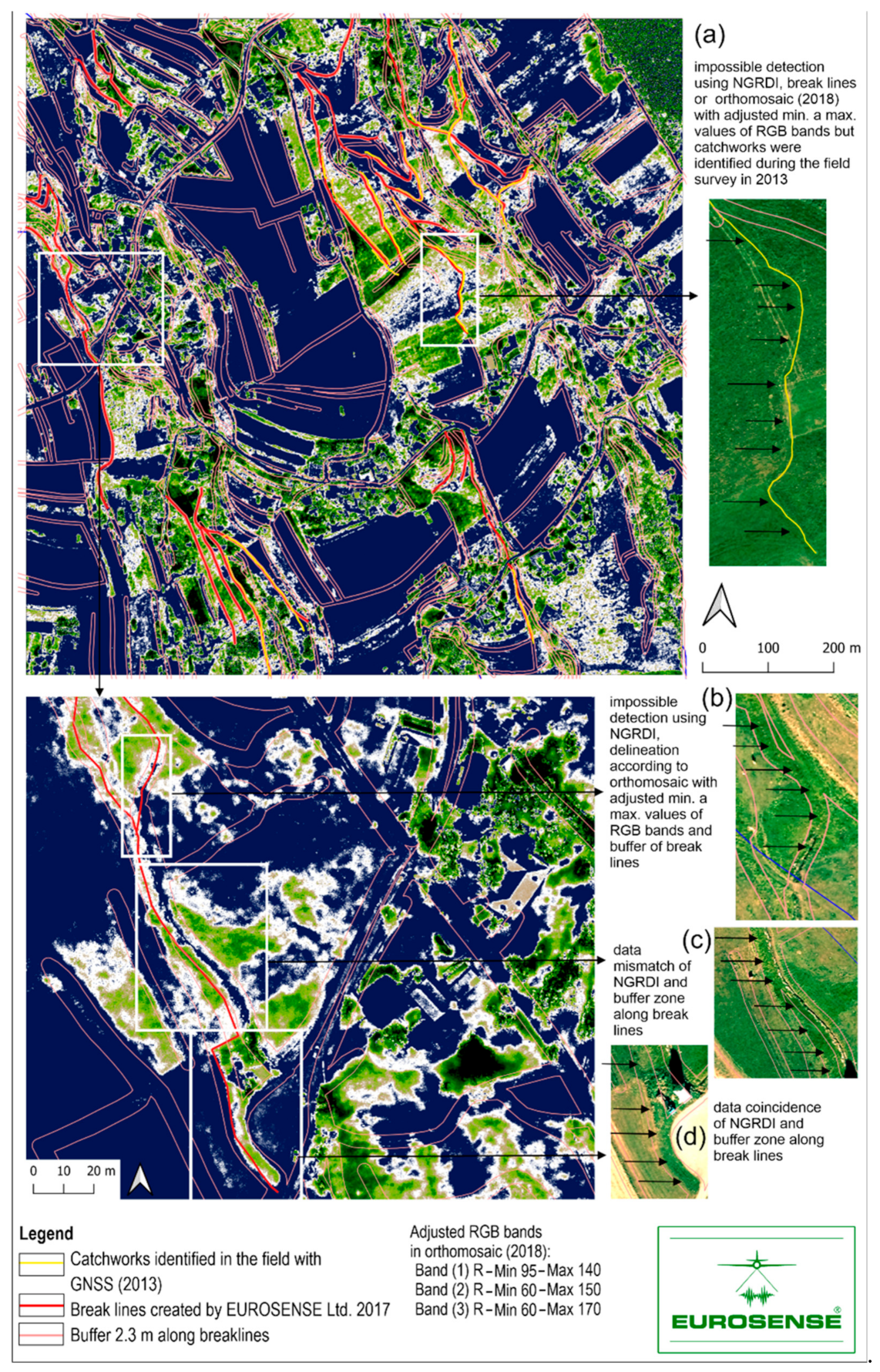
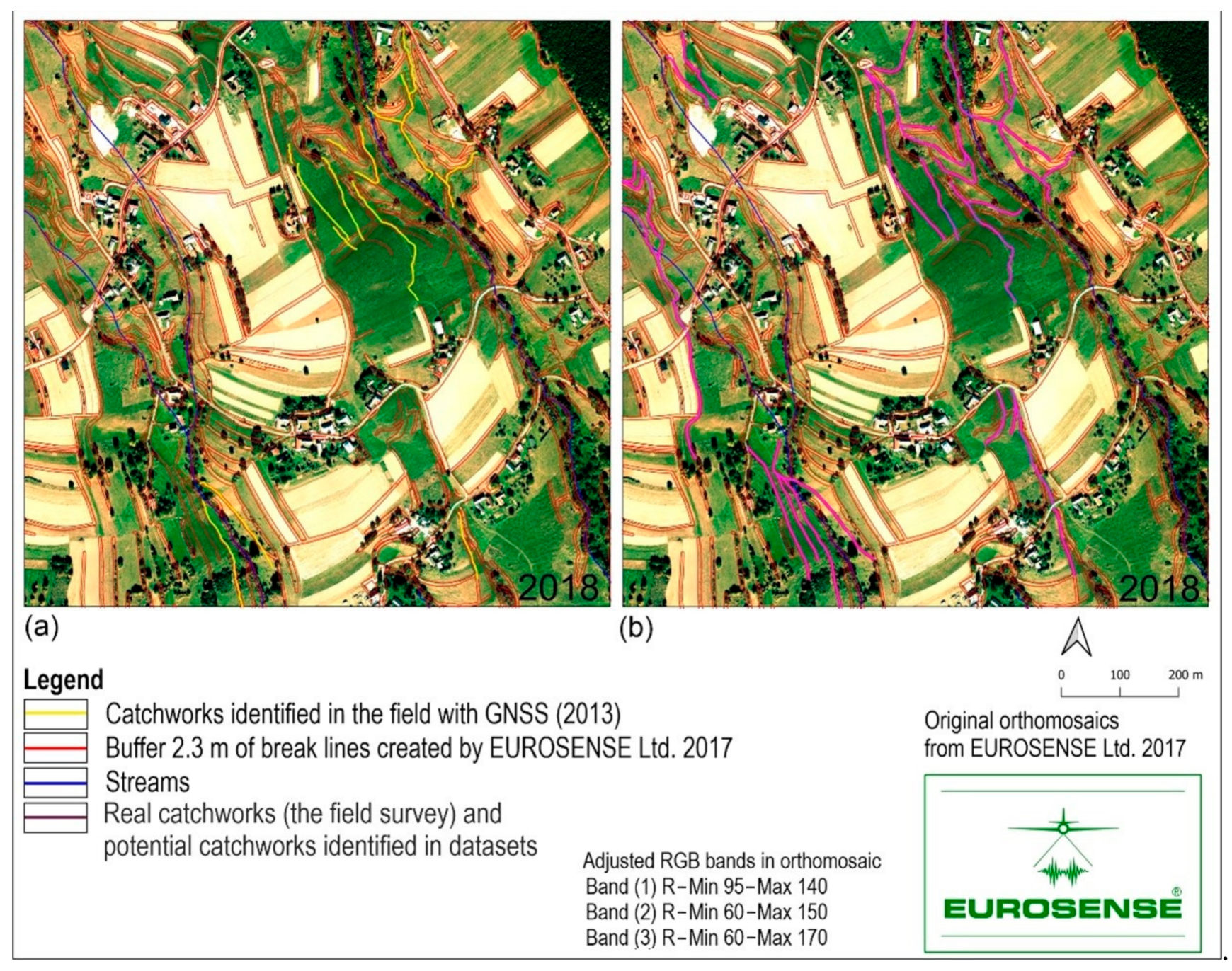
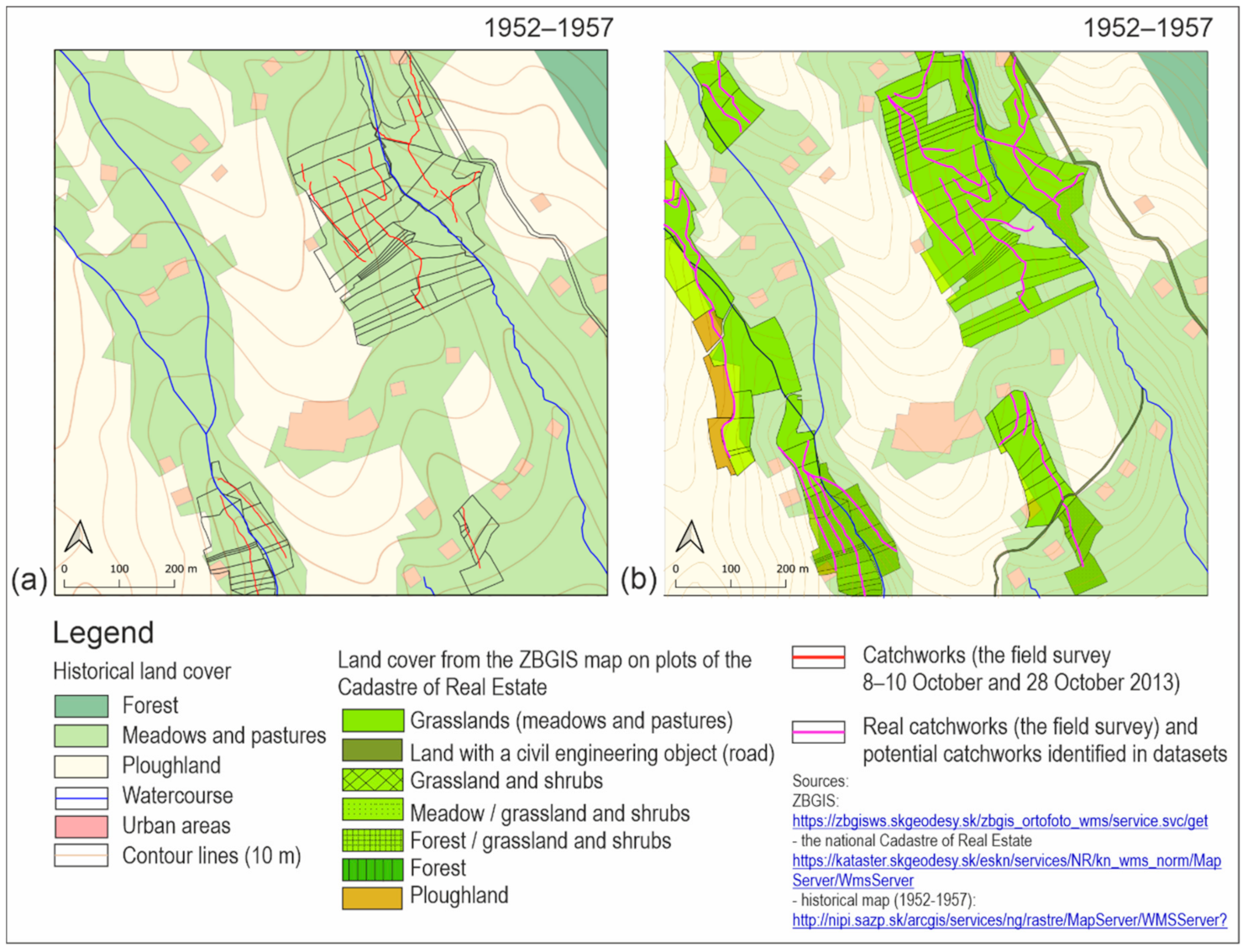
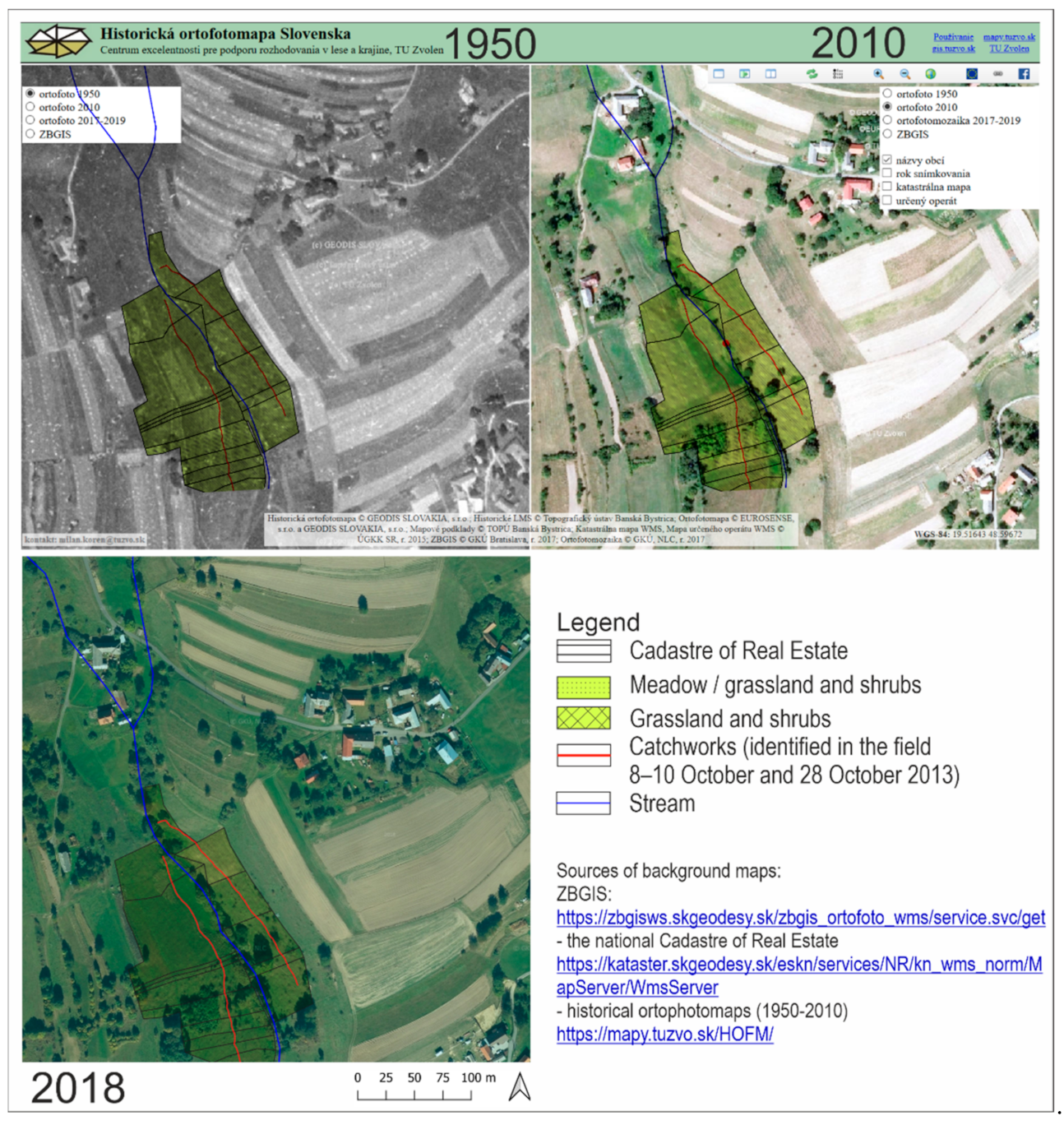
| Date | Resolution [m/px] | Bands R—G—B (Min–Max) |
|---|---|---|
| 2002 | 50 | 0–255—0–255—0–255 |
| 2006 | 50 | 16–250—26–250—14–250 |
| 2009 | 25 | 0–250—0–250—0–250 |
| 2011 | 25 | 11–255—7–255—7–255 |
| 2015 | 20 | 21–246—28–252—5–255 |
| 2018 | 20 | 28–236—25–234—22–230 |
| Geospatial Data Origin Processed in Geographic Information System (GIS) Applications | Authors | EUROSENSE Ltd. 2017 |
|---|---|---|
| Socet Set® software, BAE Systems | - | Digital terrain model (DTM) as Triangulated Irregular Network (TIN); Orthomosaic photos red (R), green (G), blue (B) (2002, 2006, 2009, 2011, 2015, 2018) |
| Quantum GIS (QGIS) București 3.12.3 and 3.14 π “Pi” | ||
| Raster analysis, Grid | Pixel based DTM gridded data from z co-ordinates of TIN | - |
| Raster calculator | DTM derivatives thresholds | - |
| Raster conversion | Vectorisation of maximum profile curvature grid cells | - |
| Raster analysis, using a zonal histogram | Zonal statistics on rasters with vector layers containing zones | - |
| Vector, geoprocessing tools, buffer | Buffer zones of break lines from TIN | - |
| Vector, the Global Positioning System (GPS) Tool plugin | Import of Global Navigation Satellite System (GNSS) data to QGIS | - |
| QGIS client to access Open Geospatial Consortium (OGC) Web Map Services (WMS) and Web Map Tile Service (WMTS) | ZBGIS® Map (Topographic maps, 2019); Plots of the national Cadastre of Real Estate; Historical data: military topographic maps (1952–1957) and orthomosaic photos (1950, 2010, 2018) | - |
| Semi-automatic Classification Plugin (SCP) v.7.2.0 for QGIS | ||
| Pre-processing, split raster bands | Split RGB to separate bands | - |
| SCP raster band calculator | Normalized Green-Red Difference Index (NGRDI) | - |
| System for Automated Geoscientific Analyses (SAGA) GIS 2.3.2 | ||
| Simple Filter | Filtered DTM with sharpened terrain discontinuities | - |
| Terrain Analysis, morphometry, profile curvature | DTM derivative indicating the increasing slope steepness in the downslope direction | - |
| Global Navigation Satellite System (GNSS) Leica GS05 | ||
| GNSS Leica GS05 | Field survey of catchworks (2013) | - |
| Land Use Categories from ZBGIS * | Length of Catchworks (%) | Area of ZBGIS Land Use Categories (%) |
|---|---|---|
| Forest | 0.12 | 1.85 |
| Forest/grassland and shrubs | 1.80 | 2.09 |
| Meadow | 69.41 | 65.08 |
| Land with a civil engineering object (road) | 0.43 | 3.16 |
| Meadow/grassland and shrubs | 3.40 | 4.58 |
| Grassland and shrubs | 24.84 | 23.24 |
| Total sum | 100.00 | 100.00 |
Publisher’s Note: MDPI stays neutral with regard to jurisdictional claims in published maps and institutional affiliations. |
© 2021 by the authors. Licensee MDPI, Basel, Switzerland. This article is an open access article distributed under the terms and conditions of the Creative Commons Attribution (CC BY) license (http://creativecommons.org/licenses/by/4.0/).
Share and Cite
Slámová, M.; Hreško, J.; Petrovič, F.; Grežo, H. Catchworks: A Historical Water-Distribution System on Mountain Meadows in Central Slovakia. Sustainability 2021, 13, 1107. https://doi.org/10.3390/su13031107
Slámová M, Hreško J, Petrovič F, Grežo H. Catchworks: A Historical Water-Distribution System on Mountain Meadows in Central Slovakia. Sustainability. 2021; 13(3):1107. https://doi.org/10.3390/su13031107
Chicago/Turabian StyleSlámová, Martina, Juraj Hreško, František Petrovič, and Henrich Grežo. 2021. "Catchworks: A Historical Water-Distribution System on Mountain Meadows in Central Slovakia" Sustainability 13, no. 3: 1107. https://doi.org/10.3390/su13031107
APA StyleSlámová, M., Hreško, J., Petrovič, F., & Grežo, H. (2021). Catchworks: A Historical Water-Distribution System on Mountain Meadows in Central Slovakia. Sustainability, 13(3), 1107. https://doi.org/10.3390/su13031107







